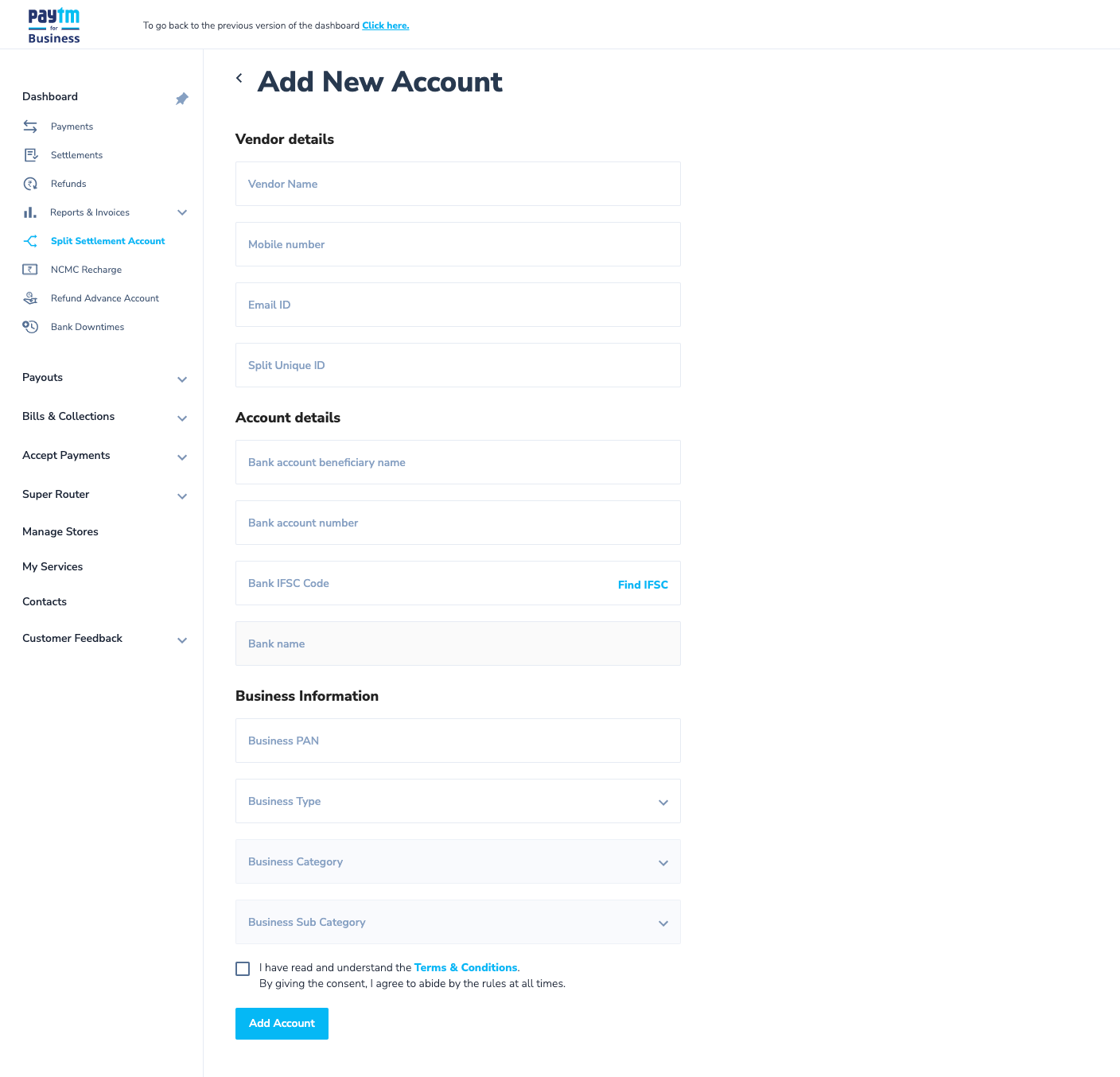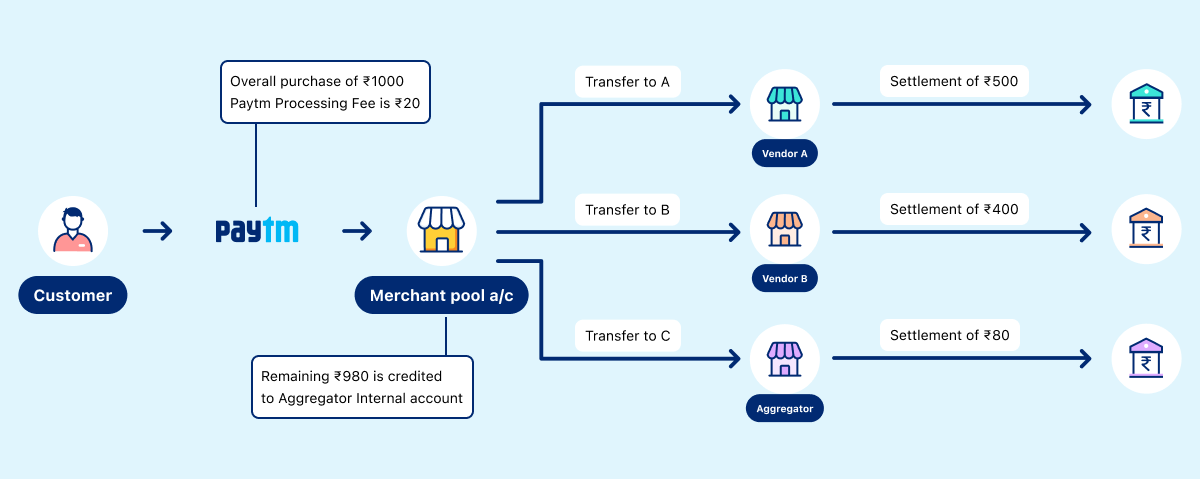Overview
Paytm Split empowers businesses to manage payouts for each order to multiple stakeholders. With each order sent to Paytm for collecting payment, intimating Paytm how much you want to settle to your vendors / partners / various bank accounts. Later, Paytm would make the seamless payouts to them. This way you could focus on growing the business and let Paytm handle the complete money movement.
You can perform the following tasks using the Paytm Split:
- Add and manage all of your vendors / linked accounts.
- Split a transaction’s Payout into multiple accounts by amount / percentage split at the time of order creation as well as post-order creations.
- Split a transaction’s Fee / Commissions (MDR+taxes etc.) into multiple accounts by percentage split at the time of order creation as well as post-order creations.
- Split refunds for such transactions from multiple accounts by amount / percentage split at the time of refund order creation.
- Vendor reconciliation using auto-created vendor settlement files.
To receive a payment’s settlement in multiple bank accounts, you must follow the steps below:-
- Add account
- Transaction split operation
- Reconciliation
1. Add account
The first step towards settling a transaction to multiple bank accounts / vendors / sellers is to on-board the accounts on Paytm PG. You can easily onboard one or multiple accounts on Paytm using the Merchant Dashboard.
Once you onboard the accounts, you’ll receive a Unique Account ID for each added account. You need to store these account IDs in your database for each account added. You must pass the Account ID on to Paytm in the split details of the transaction request in various APIs, along with the amount / percentage you want to settle to this account.
You need the following details to onboard an account:-
| Vendor Details |
- Vendor / Account Name
- Mobile Number
- Email ID
- Split Unique ID*
|
| Account Details |
- Bank account beneficiary name (@)
- Bank account number (#)
- Bank IFSC code
- Bank Name
|
| Business Informations |
- Business PAN
- Business Type
- Business Category
- Business sub-category
|
* This is an optional parameter, mainly used by merchants who already have some unique identifiers at their end for these vendors and wish to use the same in transaction flow instead of Paytm-created VIDs. so this would be a substitute for VID / account ID.
@ Bank beneficiary name should match with your bank passbook, otherwise, penny drop will fail and you will have to upload a canceled cheque for successful vendor account creation.
# Account details ( Can’t have multiple vendors with the same account details)- It includes the details.
Steps to create a Vendor account:
- Contact MHD / KAM to enable Split settlement on your MID.
- Log in to the Merchant dashboard from Parent MID credentials and select Split Settlement Account.
- Select Add a single account from the drop-down. An option to create Vendors via bulk file upload is also available.
- Fill in all the mandatory parameters in the list for Add a new account.
- Click on the tickbox for Acceptance of TnC and all details. For more details, refer to Tnc Policy.
- Split Settlement Account section can be referred to check all active, pending, and failed accounts.



Additional Features provided on the Split Settlement Account tab:
- You can view / download the account list with Account IDs from the Split Settlement Accounts tab in the dashboard.
- You can change the Bank / Contact details of a vendor using the edit function on the main merchant's dashboard.
- Vendor onboarding is near real-time, but processing large bulk files for onboarding can take up to a few minutes in account verification.
- Transactions, settlements, and refunds created using split settlement are available on this screen against each account.
- All Account IDs will have the same settlement cycle (T+1) as the original business settlement cycle.
2. Transaction Split Operation
Once the accounts / sellers / vendors are onboard, you need to inform Paytm how much amount you would like to give to which Account ID in the transaction request. Once we’ve successfully processed a transaction with those split details, Paytm will take care of creating separate payouts for all Account IDs and transfer the respective amounts.
Split settlement solution is available with all the checkout solutions and its processing steps are as follows:-
- Customer visits your website or mobile application and adds goods to the cart of different vendors / sellers and pays for the amount.
- You are required to pass the SplitSettlementInfo object in the Initiate Transaction API request, with the transaction splitting information such as method, amount, etc.
- Paytm shares a transaction token in response to the Initiate Transaction API request post-validation and you will pass the transaction token to your app / browser.
- You call the Process Transaction API using the same token. Paytm processes the transaction post validating the request and shares the status of the transaction with you. You show the transaction status as received through Paytm.
- In the case of Custom Checkout flow, call the Process Transaction API after the user has selected the payment option with the split info.
You can refer to the flow diagram below for a brief of the money flow for split settlement:-

Example of Split Settlement
- Customer goes to the main merchant's website and order goods / services worth Rs.1000.
- The merchant provides the following transaction split details:-
- Vendor A: Rs.500 (or 50%)
- Vendor B: Rs.200 (or 20%)
- Aggregator: Rs. 300 (or 30%)
- Once the transaction is successful, Paytm debits the fee(Rs.20) and credits Rs.980 into the merchant’s internal balance.
- Once the money is credited to a merchant’s internal balance, we transfer the respective amounts to the vendor’s internal balance.
- Balance in each account:
- Vendor A: Rs.500
- Vendor B: Rs.200
- Aggregator: Rs.280
- At the time of Payout (T+1), all the transactions to the main merchant & vendors are accumulated and they receive a settlement for respective amounts.
Split Settlement Info required by PG
Merchants need to pass the split settlement object in the payment APIs wherever they wish to split the payment and process multiple split settlements.
{"requestType":
"Payment","mid":"YOUR_PARENT_MID_HERE",
"orderId":"LOK_1696482773_20231005051253",
"websiteName":"DEFAULT","txnAmount":{"value":"20","currency":"INR"},
"userInfo":{"custId":"prabhat_1528099993","mobile":"7777777777","email":"abc@xyz.com","firstName":"John","lastName":"Smith"},
"splitSettlementInfo":{"splitType":"","splitMethod":"AMOUNT", "splitInfo":[
{"mid":"YOUR_FIRST_CHILD/VENDOR_MID_HERE","amount":{"currency":"INR","value":"8"},"feePercentage":"20","splitReferenceId":""},
{"mid":"YOUR_SECOND_CHILD/VENDOR_MID_HERE","amount":{"currency":"INR","value":"10"},"feePercentage":"40","splitReferenceId":""}]}}
This object (SplitSettlementInfo) consists of both optional and mandatory fields mentioned in the table below:-
| Attribute |
Description |
Status |
| splitType |
Possible values: AT_TXN / POST_TXN or blank, blank is also considered as AT_TXN |
Conditional: if POST_TXN split is required |
| postTxnSplitTimeout |
Timeout in no. of calendar days for which this txn will be in open state |
Conditional: if POST_TXN split is required |
| splitMethod |
Possible Values: AMOUNT, PERCENTAGE |
Conditional: It is mandatory for all cases except POST_TXN |
| Attribute |
Description |
Status |
| mid |
Child MID |
Mandatory |
| amount |
Amount to split on child |
Conditional: If splitMethod is AMOUNT |
| value |
Amount to split on child |
Mandatory: If splitMethod is AMOUNT |
| currency |
Possible Values: INR |
Mandatory: If splitMethod is AMOUNT |
| percentage |
Percentage share of child |
Conditional: If splitMethod is PERCENTAGE |
| feePercentage |
% of the total commission amount |
Conditional: Only If a fee split is required |
| partnerId |
Substitute of child MID |
Optional |
| splitReferenceId |
Internal Reference number that can be used in case of multi-splits on single Vendor |
Optional |
| extendedInfo (Udf1,2,3, mercUnqRef and comments) |
Any additional parameters |
Optional |
 Note:
Note:
- Make sure to use this object only for the orders where a split is required.
- In the case of POST_TXN only the first 2 attributes are mandatory in payment APIs and the rest will be sent in Post txn API.
- If the split amount for all the vendors doesn’t add up to the order amount / transaction amount, the residue amount would be settled to the main merchant.
- In the case of PCF commission mode, the split is applicable on the original order amount (Excluding commission paid by the customer).
Payment APIs where the Split object is supported:
Merchants need to pass the split settlement object in the payment APIs wherever they wish to split the payment and process multiple split settlements. This object (SplitSettlementInfo) is currently supported in the following APIs:-
Split Settlement features:
Merchants need to pass the split settlement object in the payment APIs wherever they wish to split the payment and process multiple split settlements. This object (SplitSettlementInfo) consists of both optional and mandatory fields. Using these fields, merchants have the utmost flexibility to use multiple features of split settlement.
-
Split during the transaction:
If merchants know the split at the time of order creation then the split object can be passed in the transaction API itself and the same will be used by Paytm PG to split the order and process the settlements accordingly.
-
Split after the transaction:
If you don't know the split at the time of order creation, don’t worry we’ve got you covered. You just need to inform us using splitType as POST_TXN and postTxnSplitTimeout for the number of days you want us to wait for split instructions from you. Then you can call the Post Facto Split Settlement API during this window to provide split instructions and based on that we’ll split the settlements. Once that time has expired without any split instructions from your end, the order will be 100 % processed on the main MID.
-
Fee deduction support from the respective Vendor / child MIDs:
If a merchant wants the flexibility to deduct fees, commissions, and taxes from its child / vendor accounts, then it can be done with the help of feePercentage in the same split object. We support 0 to 100 % fee deductions from Vendor accounts.
-
Refund deduction support from respective Vendor / Child accounts:
Using the same split object you can provide split instructions in refund APIs as well. It’ll work similarly to the payments and as per the requested split instructions we deduct from the respective vendor account’s settlement balances.
{"mid":"YOUR_PARENT_MID_HERE","orderId":"LOK_1696482773_20231005051253",
"refId":"alipayRef_1696483226","txnId":"231005122942122466",
"refundAmount":"17","txnType":"REFUND",
"splitRefundInfo":{"splitMethod":"AMOUNT","splitInfo":[
{"mid":"YOUR_FIRST_CHILD/VENDOR_MID_HERE","amount":{"currency":"INR","value":"7"},"splitDetailId":"","splitReferenceId":""},
{"mid":"YOUR_SECOND_CHILD/VENDOR_MID_HERE","amount":{"currency":"INR","value":"9"},"splitDetailId":"","splitReferenceId":""}]}},
3. Reconciliation
Reconciliation for settlements done to the main merchant / splitting party and the vendor can be processed via the files sent over the email to the main merchant or by downloading the settlement files from the merchant dashboard. The files sent over mail have settlement details of all vendors in one report. On the other hand, one can download settlement files for oneself and each vendor separately from the merchant dashboard.
The following views / actions can be accessed from the dashboard:-
- Vendor account level transactions: All the payments, settlements, and refunds that have a non-zero share for any particular vendor account. This can be simply accessed from the split settlement account section on the UMP Dashboard.
- Parent transactions: The Parent payments and refunds detail pages have the context of all the split orders created on this main order. It has split count, split amount, split vendor account ID, Split a/c name, split fee share, and net settlement amount.
 Note: All the Vendor-level settlements can also be reconciled with the help of our Split Settlement API.
Note: All the Vendor-level settlements can also be reconciled with the help of our Split Settlement API.




